Of the many stylistic features one associates with Brahms's music, none is more powerful than the architecture of his musical designs. Structural coherence was the genesis of his creative process, not merely the goal. The alluring idea of creative inspiration assuming precedence over the creator's conscious control was a romantic notion foreign to Brahms. It is not surprising therefore that in his personal copy of Jahn's biography of Mozart, Brahms should doubly underline the passage "In all artistic productivity, the creative, inventive force cannot even for an instant be completely divorced from the constructive, organizing one."1
Tovey, Evans, Réti, and even Schoenberg in his celebrated essay "Brahms the Progressive," are among a host of authors who have addressed the means by which Brahms architecturally develops, balances, and ultimately unifies his varied forms. We are well acquainted with the dissection of such works as the Fourth Symphony, undertaken by analysts to demonstrate Brahms's prowess in the area of motivic manipulation. Thus the mature Brahms stands as the archetype of a master musical engineer, building his impressive designs by the most economical means. Yet the study of his origins as a composer who emphasized structure above all else is an area which has not been explored sufficiently. The purpose of this article is threefold: (1) to examine the various circumstances which contributed to the initial establishment of Brahms's early awareness of formal coherence as a compositional priority, (2) through a brief historical-analytic study of Brahms's earliest surviving piano work, the Scherzo in E-flat Minor, Opus 4, to suggest an early linear resource as a nuclear technique of unification, (3) to project this youthful technique as a vital and continuing means of structural control in works from later periods of his creative activity.
I
Formulating a sharp historical perspective in which to place the earliest of Brahms's works is a difficult task. Chronological uncertainties abound. However, one may justifiably assign Brahms's formative years to a period lasting until 1853, the year the Schumanns spiritually adopted the unknown youth into their household. Since the majority of his compositional attempts preceding the first works released by Breitkopf and Härtel in 1853 were destroyed, it is impossible to ascertain just how "youthful" his earliest works actually were. Therefore in examining Brahms's origins as a musical architect we must rely almost solely upon events and influences known to have affected him in that initial student period.
In varying detail Kalbeck and other early scholars tell of Brahms's interest in orderliness and structure even as a small child. Raised in the impoverished Gangeviertel of Hamburg, Brahms's early penchant for order surely would be viewed by today's psychologists as a not-so-latent rebellion against his unordered environment. His youthful play with toy soldiers, especially his arrangement of them into various formations, is a favorite anecdote related by many biographers, perhaps implying some primordial type of genetic urge to structure matters and create order. On less tenuous ground Brahms's unquenchable thirst for scholarship, traceable to his days as a schoolboy, is firmly documented. Geiringer reports: "Brahms always used his pocket money for a subscription to the circulating library; and when as a youth, he played dance-music in little pubs and pothouses, he would set a book before him on the music rack, eagerly reading while his fingers mechanically performed the long familiar tunes."2 We have some knowledge of the books he read and music he knew. The regular purchase of such theoretical manuals as those by Mattheson, Marpurg and others is germane to an understanding of his compositional beginnings. Especially pertinent is his familiarity with the contrapuntal methodology of Fux. The familiarity with such scholarly treatises at an early age attests to Brahms's devotion to serious inquiry. Even as a young pianist in the early 1840s his programming of a fugue from the Well-tempered Clavier for public recital was highly irregular and indicative of his musical tastes. These signals reveal an exceptionally sober-minded youth absorbed in theoretically oriented materials, all of which stem from a sense of order, discipline and logic. Indeed, these are the same qualities usually associated with Brahms's "severe" compositional style and the parallel is clear. Yet an even more direct and formidable influence on the impressionable boy may be seen as a result of Brahms's apprenticeship with Edward Marxsen beginning in 1843.
The primacy of this student-teacher association as it pertains to the origins of Brahms's structural control can scarcely be overstated. Murdoch's assertion that "the years of Brahms's studentship with Marxsen do not call for much comment" offers an estimate which unfortunately is both prevalent and misinformed.3 A knowledge of Marxsen's own compositional philosophy and pedagogy is needed, for it provides the single most important clue toward understanding Brahms's early cognizance of musical structure and the fundamental means by which to achieve such formal coherence.
Brahms's instruction with the highly respected Hamburg musician originated in his desire to develop his technique as a pianist. Marxsen at first refused to accept Brahms as his student. However, following a shared instruction arrangement lasting two years (wherein Brahms studied most often with Marxsen's own protégé, Friedrich Cossel), Brahms in 1845 won a regular place in Marxsen's class. Brahms's aspirations for a career as a concert pianist (or more honestly stated, his father's aspirations for his son) were gradually preempted by time spent composing. Marxsen himself has left us with an interesting account regarding the origin of Brahms's regular compositional study with him:
I was captivated by his keen and penetrating intellect, and yet, when he came later on to original composition, it was at first difficult to him, and required a good deal of encouragement from me. Still, though his first attempts produced nothing of consequence, I perceived in them a mind in which, as I was convinced, an exceptional and deeply original talent lay dormant. . . . I therefore spared myself neither pains nor trouble to awaken and cultivate it, in order to prepare a future priest of art, who should proclaim in a new idiom through his works, its high, true, and lasting principles.4
The method of awakening and cultivating this talent may best be appreciated if first seen in the light of Marxsen's own musical dictates. Being trained in the rigours of counterpoint by his own teacher Seyfried, Marxsen's own tastes and techniques had been tailored carefully at an early age.5 His own compositions, numbering over sixty, espouse a Mendelssohnian classicism of which Brahms was the eventual heir. Perhaps his best known work, Beethoven's Schatten (1844-5), suggests Marxsen's decided affinity for Brahms's spiritual predecessor. That Marxsen had orchestrated the Scherzo from the Opus 106 Hammerklavier Sonata with great popularity further indicates his compositional attitude—an attitude which was surely fostered and transmitted to Brahms.
Marxsen emphasized two areas in his teaching: Linear invention and its logical elaboration, and a thorough familiarity with the principles of classical form. Florence May, perhaps the most informative commentator regarding this particular point, describes Marxsen's method:
He began by training (his students) in the art of developing a theme. Taking a figure or phrase from one or another of the great masters, he would desire the pupil to exhibit the same idea in every imaginable variety of form, and would make him persevere in this exercise until he had gained facility in perceiving the possibilities lying in a given subject, and ingenuity in presenting them. Pursuing the same method with material of the pupil's own invention, he aimed at bringing him to feel, as by intuition, whether a musical subject were or were not suitable for whatever immediate purpose might be in view. The next step was that the idea should be pursued not arbitrarily, but logically, to its conclusion—a conclusion that was not, however, allowed to be hard-and-fast termination. Marxsen's pupils were taught to aim at making their movements resemble an organic growth, in which each part owed its existence to something that had gone before. "Unity clothed in variety" might have been his motto.6
This marked emphasis on the line and its development was undoubtedly a result of Marxsen's own contrapuntal studies with Seyfried. Moreover, Marxsen so stressed this linear dimension that assignments in part-writing were virtually excluded. Perhaps Marxsen ignored the detailing of harmonic procedures because he himself was (according to May) "not trustworthy" in this particular area. How paradoxical this seems, given the fact that Marxsen was such a taskmaster in all other disciplines of elementary training. It would seem reasonable to assume, therefore, that in his teaching Marxsen must have created the impression, unintentionally or otherwise, that harmony was to be considered almost as a by-product of the individual line. It is a pedagogical stance which implicitly argues that if linear control is skillfully exercised, firm harmonic underpinnings will result almost naturally. This is not to suggest that Marxsen was not fully aware of the necessity of harmonically structural pillars in his teaching of the traditional forms; rather it serves to illustrate just how highly valued the line and its subsequent Durchführung were prized in his instruction.
The depth of Brahms's acceptance of Marxsen's teaching concerning this specific aspect is revealed in the study of Brahms's early works. Furthermore it should not be conceived as a mere patronizing acceptance to be quickly discarded once the student completed his apprenticeship (as will be seen in the latter two sections of this study). Long after he had left Marxsen, Brahms regularly solicited Joachim's criticism about a new work. Joachim's reactions, sometimes negative at first, often stemmed from his misunderstanding of Brahms's polyphonically inspired writing. In Joachim's opinion, the resultant harmony was too harsh because of Brahms's clashing of individual voices.7 Such evidence suggests that Marxsen's influence on Brahms was very powerful and far-reaching. Recently commenting on this linear emphasis as being crucial to Brahms's composing method, Bernard Jacobson has at the same time given us an appropriate summary of Marxsen's primary pedagogical tenet: "It is the insistence on the integrity of the individual line . . . that seems to leap clear back over the previous two centuries to a time before the monodic revolution had shifted composers' concentration from the horizontal to the vertical aspects of music."8
Concerning Marxsen's second pedagogical emphasis, a thorough understanding of the traditional principles of classical structure, our knowledge of several works Brahms composed during this time—then later destroyed—further indicates his close adherence to his mentor's advice. The lamentable destruction of these scholastic efforts prevents an assessment of the scope and quality of work accomplished during this novitiate. Schauffler casually asserts that hundreds of compositions were completed during this time.9 While that estimate appears both inflated and unproven, there is evidence to suggest that Brahms employed a variety of formal procedures in these lost works. For example we know from Schumann's Neue Bahnen that by the time of Brahms's arrival in Düsseldorf in 1853, there were sonatas, trios, piano pieces and quartets. Even earlier there is documentation of Brahms's 1849 public performance of his own Fantasie on a Favorite Waltz, several student sonatas written under the pseudonym G.W. Marks and according to the pianist Louise Jappa (a contemporary of Brahms) a piano sonata of 1844, written during the early days with Marxsen.
In the aftermath of Brahms's decision as to which pieces were worthy for publication, most of this juvenilia was destroyed.10 Even so, from works known to be destroyed we can conjecture as to the substantial degree of familiarity with classical designs. Brahms's choice of which of these early works were to be released and which were to suffer destruction was apparently a difficult task. His caution and agony in reaching that decision are reflected in his letter to Schumann, dated November 16, 1853:
The public praise you have deigned to bestow upon me will have so greatly increased the expectations of the musical world regarding my work that I do not know how I shall manage to do even approximate justice to it. Above all it will compel me to exercise the greatest caution in my choice of pieces for publication. I am thinking that I shall not publish any of my trios but shall select the Sonatas in C and F sharp to be my Opus 1 and 2. Opus 3 will be the songs, and Opus 4 will be the Scherzo in E flat minor. You will readily understand that I am straining every nerve to bring as little disgrace as possible to your name.11
These remarks imply that because the choice was difficult the quality of at least some of the discarded scores might not have been much inferior to those selected for publication. Of this first published set the Scherzo in E-flat Minor, although it carries the Opus 4 number, was actually the first of the piano works to be written. In the shadow of the more imposing triptych of sonatas composed about this time, it is often forgotten. The design of this early publication is in itself significant, for it shows Brahms's accomplished handling of a form which was to undergo a continual metamorphosis throughout his creative career. This Scherzo, written at 18 years of age, presents the earliest opportunity to examine Brahms's youthful concept of structural control.
II
Unquestionably Marxsen exerted a steady influence on the youth's growth as a composer. It seems reasonable to assume, therefore, that this Scherzo was not a radical departure from pieces contemporary with it. Very likely it is representative of other works written about the same time but destroyed. What are the circumstances, then, that prompted Brahms to permit this particular work to serve as the dividing line between what was to be forever lost and what was to belong to posterity?
The Opus 4 Scherzo enjoyed a favorite place in Brahms's early performing repertoire. When he was introduced to Joachim in Hanover, this was the work that he first played to his soon-to-be confidant. Likewise in Düsseldorf, it served as Brahms's introduction to the Schumanns. In a letter to Breitkopf and Härtel of November 3, 1853, Robert described the work as "great" asking eight louis d'or for it on Brahms's behalf. Even more interestingly, when Remènyi introduced Brahms to Liszt in Weimar (during their concert tour of 1853), Liszt himself played the work since Brahms could not be persuaded to perform it.12 Liszt was so taken by the work's vigor that he immediately repeated his performance. Surely all of these incidents swayed Brahms to include this work in his first published set. Yet Brahms, self-critical even then, must have been confident of the quality of the Scherzo prior to these reinforcing events; otherwise it is unlikely that he would have offered it as his introduction to such eminent musicians.
Also in view of his aforementioned training with Marxsen in the principles of classical design, it is not surprising that Brahms would feel especially at ease with this form. For as Gal suggests, the scherzo, more than most normative structures, posed fewer compositional problems since "the quintessence of the form is that, from a single rhythmic impulse, it can develop with narrowly confined thematic material."13 Brahms's attraction to the scherzo as a viable form is further verified by several other efforts employing this design: for example, Brahms's first published chamber music was the violin-piano Scherzo of 1853. That Brahms chose this particular movement as his personal share of the jointly written F.A.E. Sonata, lends further testimony to his assuredness in this form.14 The three early piano sonatas exhibit the strongest structural coherence in their respective scherzos. Finally, when Brahms in 1890, with scalpel in hand, drastically revised his 1854 Trio in B Major, Opus 8, it was the Scherzo alone which escaped radical surgery.
It has been suggested that the Opus 4 Scherzo may be the sole survivor of an early piano sonata. Ehrmann reports that the autograph of the C Major Piano Sonata, released as Opus 1, carries the title "Vierte Sonata."15 This at least allows for the possibility of the Scherzo's extraction from a larger, earlier work. Still, because of its enormous length (over six hundred measures) compared to its counterparts from the three published piano sonatas, such a prospect seems unlikely.
Though Brahms was a faithful disciple of Marxsen's teachings, such devotion did not preclude the youth's attention to the ideas of other composers; nor did his knowledge of traditional formal conventions impair his own experimentation in constructing his own designs. The relatively unorthodox expansion of the macroform to include a second trio is noted in this Scherzo (which also strengthens a case for the work's independent conception). The temptation to credit this formal enlargement to Schumann's influence must be resisted, for Brahms knew nothing of Schumann's compositions in 1851. More apparent is the overall spirit of Chopin—which Brahms adamantly denied when questioned about the similarity of styles—especially in the work's pianistic élan.16 Yet whatever eclectic features are to be observed, above all else it is Brahms's concern with and control of the linear dimension of this work that are most impressive. A specific and traceable linear technique serves as the germinal idea of the composition and organically links all subparts to the whole.
Consider first the very opening of the work as seen in Example 1.
Ex. 1. Scherzo, Opus 4 measures 1-9

From Edition Peters No. 3300a; reprinted by permission
The pervasiveness of the initial rhythmic figure is clear (marked x in example). Central to the thematic construction of the passage is the crucial conjunct linear descent, which begins at the high point of the section's pacing (based on the strength of textural and harmonic factors, and marked y). One might even speculate as to the substructural direction of the opening rhythmic figure's pitch content, which seems to presage this overall thematic descent. Allowing for octave displacement, a reduction of the complete melodic gesture reveals a basic linear unity fundamental to the work's construction.
This linearly inspired gesture, observable at the outset of the piece, generates the thematic contour for the remainder of the work. This kinship may be seen by comparing the above example with the similarly descending line which begins at measure 18 and marks the climax of the first section.
Ex. 2a. Scherzo, Opus 4 measures 15-31
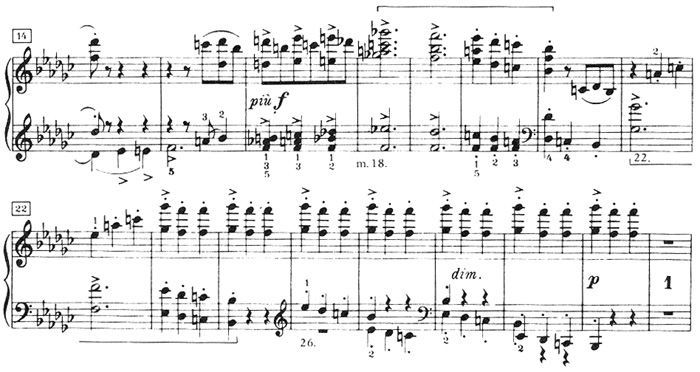
From Edition Peters No. 3300a; reprinted by permission
The left hand statement of this same material (measures 22-25) and the motivic truncation and overlapping that follow (measures 26-30), all founded upon the opening linear descent, furnish an early example of Brahms's adoption of a developmental technique usually associated with later works, such as the section (in piano reduction) quoted from the Symphony in C Minor, Opus 68 (Ex. 2b).
Ex. 2b. Opus 68, I, measures 236-238 (piano reduction)
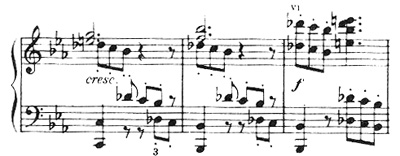
Even Brahms's borrowing of a popular theme from Marschner's opera Hans Heiling is built upon a linearly conceived pitch content. Example 3a reproduces the original Marschner idea and its derivative as extensively used by Brahms in the b section of the overall binary form (Ex. 3b).
Ex. 3a. Scherzo, measures 46-53 (Marschner theme)

Ex. 3b. Scherzo, measures 68-77

Furthermore, as Geiringer has observed previously, the percussive three quarter-note accompaniment seen in Example 3, as extracted from this b section, is first observed in the a section of the work (see right hand figuration in Example 2a above). This figuration serves an analogous function for both parts of the binary structure of the Scherzo. Thus both parts of this first principal section of the entire composition are integrated by this specific linearly formed material and accompanimental rhythmic figuration.
Admittedly, the linear-rhythmic bond between subparts of a binary form is not entirely unexpected. But Brahms's sense of formal integrity extends beyond this section of the overall macroform. As seen by comparing the previous examples with the opening of Trio I (Ex. 4), Brahms exercised a conscious control over the larger parts of the design through this same basic technique of linear unification.
Ex. 4. Trio I (from Scherzo), measures 1-9

From Edition Peters 3300a; reprinted by permission
Despite the rhythmic and textural differences the thematic relationship between scherzo and trio is obvious, perhaps even blatant, when compared to the later almost subliminal links Brahms uses as organic connections throughout a work's subdivisions. Even in this early work a more subtle but equally significant structural link is seen in the opening of Trio II, reprinted below in Example 5a.
Ex. 5a. Trio II, measures 1-9
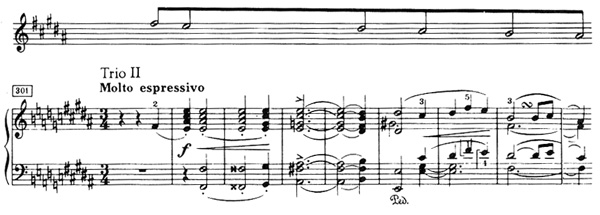
The subsequent extension of the descending line is observed in Example 5b as it is stated over the texturally Chopinesque figuration.
Ex. 5b. Trio II, measures 18-27
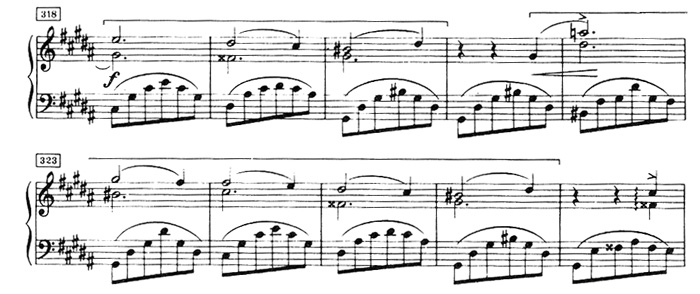
From Edition Peters 3300a; reprinted by permission
Although a measure-by-measure analysis of the entire work would prove the above illustrations to be representative of the scope of this technique, some material stems from an intervalically disjunct origin, perhaps as a purposeful contrast. The passage quoted below and excerpted from Trio I appears to be unrelated to the linear ideas seen in the previous examples. Yet even when this independently engendered motive reappears in the second part of the Trio, it is compatible with the opening theme and is eventually absorbed into the linear descent (Ex. 6b).
Ex. 6a. Trio I, measures 39-49

Ex. 6b. Trio I, measures 122-139
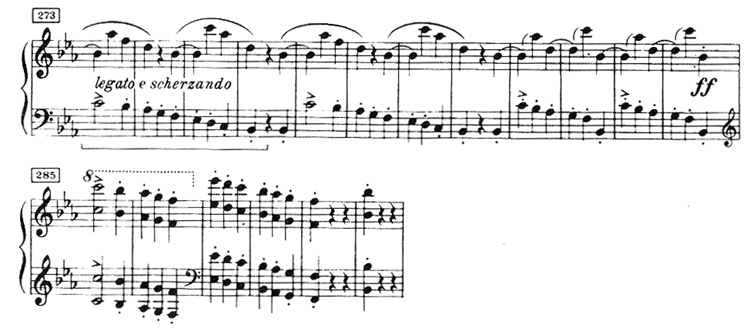
From Edition Peters 3300a; reprinted by permission
The attribution of purpose to a specific compositional idea is at best speculative and nearly always suspect without the benefit of primary source materials such as sketches. Yet such a compatibility of materials and overt usage of linear unity as mentioned above must be more than pure coincidence. Not only do Marxsen's methods support such a possibility of conscious control but Brahms himself has addressed the issue. In his own diary entry in 1855 of Lessing's maxim, Brahms surely was alluding to the type of structural concerns which occupied him in a work such as the Scherzo: "Without inner cohesion, without the most intimate connexion of each and every part, music is nothing but a sandheap, incapable of any lasting impression. Inner cohesion alone can make of it the solid marble, on which the hand of the artist may immortalize himself."17
III
That such "connexions" exist in the Scherzo at least is clear. But to what extent is this linear unification representative of Brahms's structural control in other early and even later works? If this technique is to be perceived as a kind of recurring Urlinie, then its use must be demonstrated beyond this single work. Although such a study obviously rests beyond the province of this article, I submit that this linearly structured technique is consistently applicable throughout Brahms's compositional productivity. In this concluding section a brief examination of three additional works is offered in the hope of drawing attention to this aspect of Brahms's structural mastery. I have already suggested that the Scherzo exhibits a unifying technique which in all probability is typical of Brahms's control to be found in other works of that period, perhaps even in some of the destroyed works. If this is true then the same type of structural coherence should be demonstrable in the published compositions contemporary with the 1851 Scherzo. Of the other pianoforte works released in the early 1850s the Sonata in F Minor, Opus 5 is the most familiar. Evans argues for the cyclic nature of the five-movement work through an investigation of common thematic bonds between movements, especially the Scherzo (third in order) and Finale.18 These "subtle allusions" as he terms them may be defensible but fail to address the more fundamental matter of the pitch content and order used to create these links. Consider the linear contour of the following principal motivic/thematic ideas drawn from the Opus 5 Scherzo and Finale:
The seminal resource from which all the above thematic material is derived is clearly linearly inspired. In some cases the pitch contour is transformed as in the inversion of Example 7b or contrapuntally treated as in the canonic passage built on the motive of Example 7e. Nevertheless in every instance the musical gesture springs from the germinal idea noted above.
Ex. 7a.

Ex. 7b.

Ex. 7c.

Ex. 7d.

Ex. 7e.
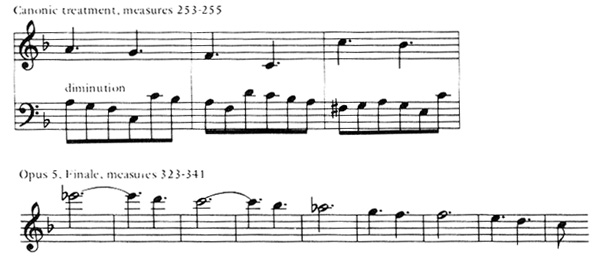
A passage from the Piano Quartet in A Major, Opus 26, completed more than twenty years later, is especially interesting since it affords a relatively rare case in which a preliminary sketch is preserved. This rather atypical survival stems from the fact that the fragment was written on the cover page of the Handel Variations, Opus 24, rather than amidst other sketches of the Quartet, which were routinely destroyed. The final form of this passage as Brahms submitted it for the published score is reprinted in Example 8. The linear descent of the piano is evident.
Ex. 8. Piano Quartet in A Major, Opus 26, II, measures 77-82

Yet on the basis of this observation alone one cannot deduce that the line was the creative impetus for Brahms's conception of this transitory section. A comparison of Example 8 with the preliminary sketch (see Plate 1) is enlightening, for it at least implies a linear pre-eminence in this phase of Brahms's actual compositional process.
Plate 1. Preliminary draft of measures 75-88
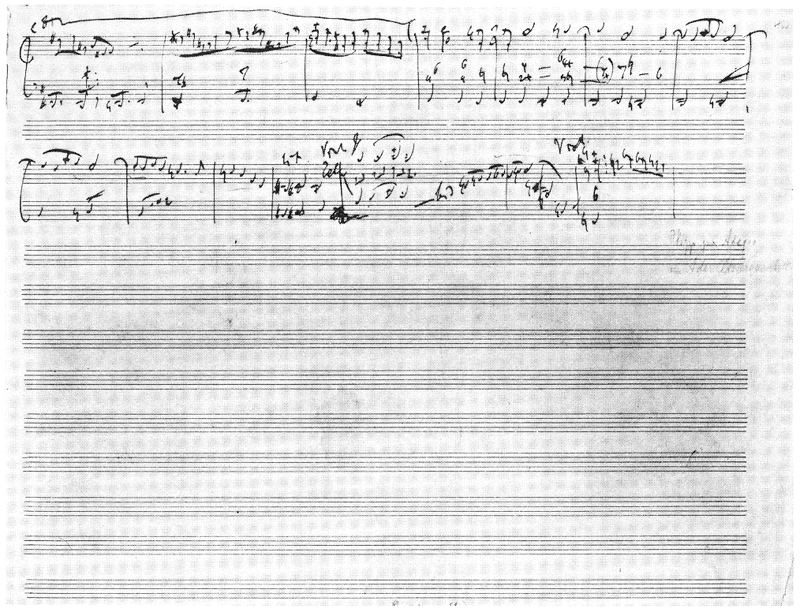
Holograph in the Gertrude Clark Whittall Collection in the Music Division of the Library of Congress; reproduced by permission
The same descending line, fully realized in the draft, remains unaltered in the printed version.19 Conversely the sketch shows only the skeletal outlines of other elements. Details of harmony, rhythm and texture are at a much less focused stage and ultimately undergo considerable elaboration before the version seen in Example 8 is completed.20
Even in the works of his later years Brahms's reliance upon this linear agent in the attainment of structural unity is demonstrable. The opening of three of the Klavierstücke, Opus 118, composed in 1892 (forty years after the Scherzo, Opus 4) exhibit the same technique. The Intermezzo employs a descending line which encompasses the entire first section of the piece (Ex. 9a);
Ex. 9. Opus 118 Klavierstücke
Ex. 9a. Opus 118, No. 1, Intermezzo, measures 1-10
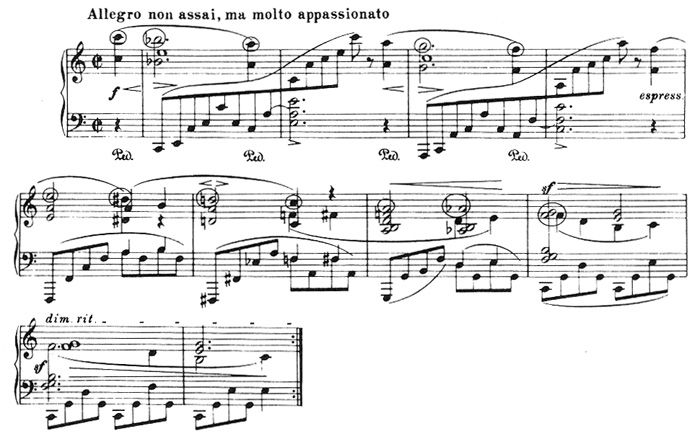
the well-known Ballade also begins with a complete statement of a falling scale (partially as a consequence of the harmonic sequence, see (Ex. 9b);
Ex. 9b. Opus 118, No. 3, Ballade, measures 1-4

and finally the initial phrase of the Romanze reveals a similar linear pattern (Ex. 9c).
Ex. 9c. Opus 118, No. 5, Romanze, measures 1-3

From Johannes Brahms, Complete Works for Piano Solo in Three Volumes, Vol. II (G. Schirmer, Inc. 1949); reprinted by permission
To compare the overall structural control exercised in an autumnal work like Opus 118 with the youthful Scherzo Opus 4 is in many respects unjust. The creative experience gained from the natural maturation of a composer who continually refined his craft separates the two works. Yet while the musical environments of the two pieces are distinctly different, in both cases the centrality of the line as a means of achieving unification is remarkably similar. Historians seem to delight in the pigeonholing of a composer's works into stylistically insular periods. Such a categorization in Brahms has always been more elusive. Perhaps one reason is the consistency and emphasis of the specific linear resource addressed here which permeates works at all stages of his compositional evolution.
For most composers the command of musical architecture evolves slowly. It is an earned technique, a competence which is almost measurable from one work to the next. The rate at which it is attained might even reliably serve as one barometer of a composer's development. To some extent at least, Brahms is an exception. Structural unity, the very cornerstone of his musical designs, is already evident in his earliest surviving works. Furthermore the evidence of this linear unity surpasses the superficial motivic tracing often associated with analyses of his compositions. For his linear usage is pervasive, cogent, and is the very nucleus of his constructive process. It is the progenitor of his structural concept of music. Moreover this control was apparent in works written before his twentieth year and remained essentially unaltered into the masterpieces of his maturity.
1Hans Gal, Johannes Brahms (New York: Knopf, 1963), p. 155.
2Karl Geiringer, "Brahms as a Reader and Collector," The Musical Quarterly XIX, No. 2 (April 1933), 158.
3William Murdoch, Brahms (London: Rich & Cowan, Limited, 1933), p. 25. For one of the few summary accounts of Marxsen's association with Brahms, see R.A. Dietrich's article "Brahms' Lehrer Edward Marxsen," Zeitschrift für Musik, Vol. 114 (May 1953), pp. 284-5.
4Florence May, The Life of Johannes Brahms (London: Arnold, 1905), I, 68.
5Ignaz Xavier Seyfried (1776-1841), a student of Haydn and composer of numerous operas and Singspiele, is perhaps best remembered for his contributions as an author. He was the editor of Albrechtsberger's complete works and Beethoven's Studies in Counterpoint (1832).
6May, I, 149.
7See Volumes 5 and 6 of Brahms Briefwechsel, ed. Andreas Moser (Berlin: Deutsche Brahms-Gesellschaft, 1908-14), which contains Joachim's correspondence.
8Bernard Jacobson, The Music of Johannes Brahms (London: Tantivy Press, 1977), p. 38.
9Robert H. Schauffler, The Unknown Brahms (New York: Crown Publishers, 1933), p. 39.
10There are two documented exceptions: The survival of a Piano Trio in A Minor was probably unintentional. A discussion of this work and a defense of its authenticity, appears in Arno Mitschka's Der Sonatensatz in den Werken von Johannes Brahms (Gutersloh, 1961), pp. 355-6. Also a Sonata for Violin and Piano, originally intended for publication by Brahms as Opus 5 (a number which the Piano Sonata in F Minor inherited) did survive but was later lost. For an excellent compilation of the facts which surround this curious work, see William Newman's The Sonata Since Beethoven (Chapel Hill: University of North Carolina Press, 1969), p. 327.
11Letters of Clara Schumann and Johannes Brahms 1853-1896 ed. Berthold Litzmann (New York: Vienna House, 1973), pp. 1-2.
12Schauffler, p. 33.
13Gal, p. 159.
14This work, with opus number, was written as a birthday tribute to Joachim. Schumann and Dietrich were the other contributors.
15Alfred Ehrmann, Johannes Brahms: Weg, Werk, und Welt (Leipzig: Breitkopf und Härtel, 1933), p. 116.
16Brahms's knowledge of Chopin in 1851 remains somewhat mysterious. When pressed about the Chopinesque character of the Scherzo, Brahms disavowed any knowledge of Chopin's music. Both Dietrich and Kalbeck have attested to this. Nevertheless the Chopin literature was widely circulated by 1851 and Marxsen regularly used these piano works in his teaching.
17Schauffler, p. 301, referring to Gotthold Ephraim Lessing.
18Edwin Evans, Historical, Descriptive, and Analytical Account of the Entire Works of Johannes Brahms (London: Reeves, 1912-1936), IV, 96-100.
19The holograph copy of the Handel Variations on which this sketch appears is held by the Library of Congress.
20Sketches of this kind are not unusual for Brahms. For example the drafts of the first movement of the Sonata in F Minor, Opus 120, No. 1, also show a well formulated linear concept (without harmonic detail) at an early stage.


